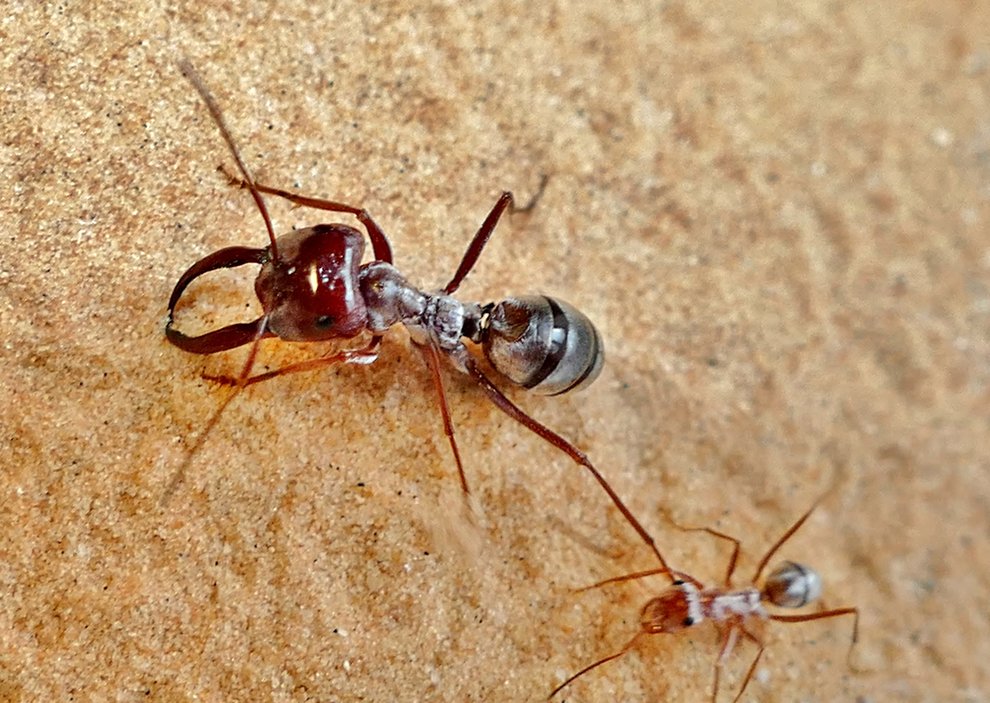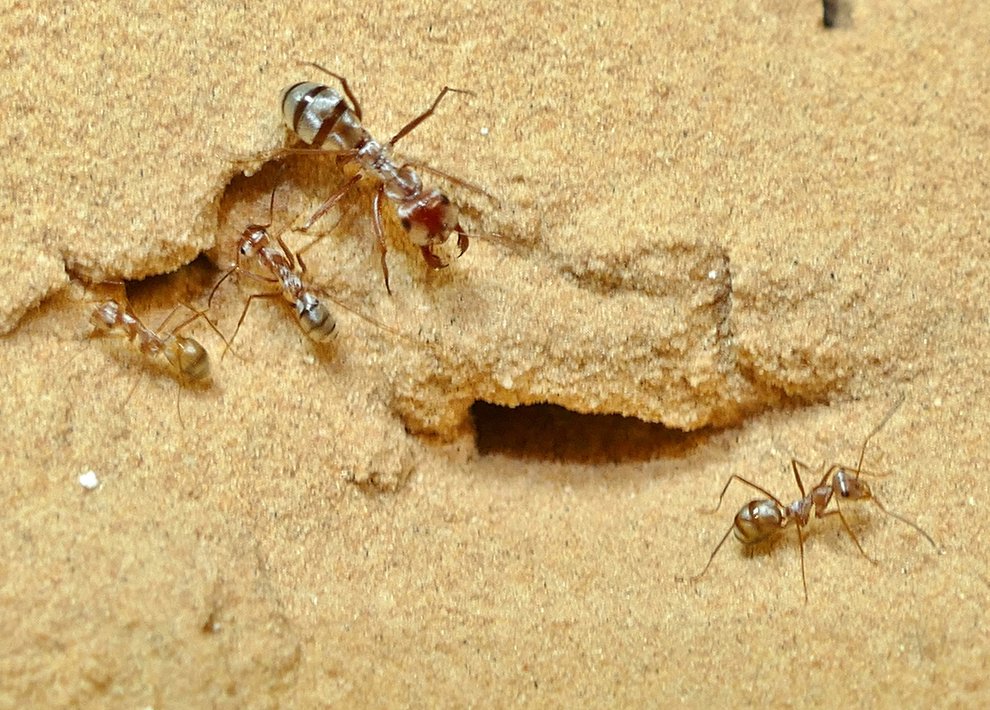World’s fastest-running ant scuttles over scalding Saharan sands at super speeds
Saharan silver ants don’t have the longest limbs. But they make up for it with a sprightly combination of fast pacing, light-footedness, and synchronized stepping that effectively turns their six legs into two.

To surpass these ants in speed relative to size, a 6’5” human would have to run at about 475 miles per hour. Image Credit: Matthias Wittlinger, Ulm University and University of Freiburg
On Saturday, Eliud Kipchoge of Kenya ran the world’s first sub-two-hour marathon, dashing 26.2 miles in 1 hour 59 minutes 40 seconds. His astounding 13-mile-per-hour pace—just under half the 27.8-miles-per-hour rate of Usain Bolt’s record-breaking 100-meter sprint—made headlines around the world for shattering a barrier many people once considered impossible to break.
Members of the insect world, however, are less easily impressed.
Scaling swiftness to size, there are plenty of six-legged speedsters that could leave both Bolt and Kipchoge in the dust. Among them is the startlingly sprightly Saharan silver ant (Cataglyphis bombycina), an African native that can travel up to 108 times its body length in a single second. Bolt’s best is closer to 6 body lengths per second. To catch up, he’d need to blaze down a track at about 475 miles per hour.
So, yeah. The Saharan silver ant is very fast. Fast enough that this centimeter-long speed demon currently holds the title of world’s speediest ant, says Harald Wolf, a neurobiologist at Ulm University in Germany, who’s spent years scuttling after the desert-dwelling insects.
Now, with the help of some mealworms and a high-speed camera, Wolf and his team have found a way to clue in to how Saharan silver ants accomplish their fleet-footed feat. Their study, published today in the Journal of Experimental Biology, shows that C. bombycina uses a deft combination of fast pacing, light-footedness, and synchronized stepping to trounce the competition—including a closely-related species that boasts longer legs.
“To make yourself faster, minimize contact with the ground,” says Crystal Reynaga, a biomechanics expert studying animal movement at Duke University who wasn’t involved in the study. “I think that holds true for an ant or a human.”

Saharan silver ants are especially cool—for more reasons than you might think. The hairs on their body can reflect sunlight back into the atmosphere, keeping them from overheating. Image Credit: Harald Wolf, Ulm University
Champion runners like Bolt and Kipchoge might make their living by being fast. But for the residents of the Sahara Desert, speed and surefootedness are an even bigger matter of life or death. Here, ants like C. bombycina survive as scavengers, feasting on the bodies of other insects that have perished in the sweltering sands—a macabre menu best served midday, when temperatures can exceed 140 degrees Fahrenheit.
The more time the ants spend foraging for food, the more vulnerable they are to the blistering heat and predators that hanker after sun-roasted bugs. To shorten their stints out of the nest, these insects have evolved two superpowers: expert navigational skills and breakneck speed.
To scope out the specifics of the latter, a team led by Wolf and neuroethologist Sarah Pfeffer ventured deep into the Tunisian sector of the Sahara. Where the soil was loose and sandy, the researchers picked out nests of C. bombycina ants, before meandering into the region’s salt flats for colonies of Cataglyphis fortis, a speedy sister species that does most of its moving on hard clay.
The team first funneled sand-filled tubes into the ants’ nests and baited them with mealworms. Once the insects emerged, a high-speed video camera snapped shots of their movements. The researchers then hauled several specimens of both species back to the lab to repeat their experiments in more temperate conditions.
On average, both species of ant ran faster at higher temperatures. But each petered out at a different max speed, with the clay-dwelling C. fortis topping out at around 620 millimeters per second, while its silver-toned cousin zoomed by at rates up to 855 millimeters per second.
Weirdly, the more sluggish C. fortis is actually the ant with longer limbs—an advantage that could theoretically give it a leg up (or six) on its kin, Pfeffer says.
But C. bombycina doesn’t just overcome its stubby gams: It leverages them to pick up the pace. “When you have a shorter limb, there’s less mass to get moving,” Reynaga explains. “That makes it a lot easier to turn that thing over quickly.” This then allows the insects to take more frequent steps and spend less time with their feet on the ground.
Silver ants also seem to be exceptionally spry. When humans run, they enter what’s called an aerial phase, when both feet completely leave the ground. Silver ants can do the same with three times as many legs, and at surprisingly slow speeds—as low as a pokey 120 millimeters per second.
Getting airborne early has its perks. It means animals can essentially glide forward through the air. Here’s the ironic bit: Silver ants achieve this by acting as though their six legs are two—not unlike us humans, Wolf says. (Here, at least, is some validation for Bolt and Kipchoge.) This odd phenomenon is called an alternating tripod gait, where the front and back legs on the right and the middle leg on the left move in synchrony, and vice versa. Each tripod acts as its own cohesive, triangular foot, allowing the ant to jog in a near-bipedal fashion.
Wolf thinks this careful coordination might help the ants stay upright as they skirt around on the Sahara’s loose, slippery sands. In an unstable environment like this, he says, alternating between two tripods is a pretty good way to evenly distribute your body weight.
For C. fortis, which lopes around on salty, packed clays, the slip factor is much less of an issue, Wolf says. Here, the perks of long legs may be enough on their own.

Saharan silver ants are expert navigators. When they venture out of the nest, they keep track of the sun’s position and use it to guide themselves home. Image Credit: Harald Wolf, Ulm University
The difference boils down to simple ecology, says Ravindra Palavalli-Nettimi, an entomologist and ecologist at Florida International University who was not involved in the study. The ants have a lot in common, down to their similar body plans, he says. But each species evolved its own strategy for speed, tailored to the demands of its own environment.
Still, victory’s all relative—and the silver ant shouldn’t get too cocky. When the arena’s expanded to all insects, at least of its two terrifyingly fleet-footed relatives can still zip ahead: the Australian tiger beetle and the Californian coastal mite, which can travel up to 171 and 323 times their body lengths per second, respectively.
Pfeffer suspects the mite’s shocking speed might have something to do with its size. At just 0.7 millimeters long, it might be able to use its muscle mass more efficiently and deal with less drag from the surrounding air. The briskness of the beetles, which are comparable in size to desert ants, is a bit more mysterious.
Better luck next time, C. bombycina. Stuck in third place, you might be better known as the Saharan bronze ant.




